

|
|
Tweet
|
|
|
|
|
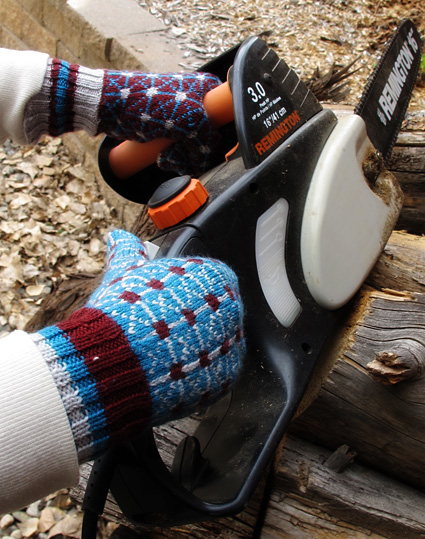 "I'm staying home this year," I say. "But didn't you go...to Oklahoma? ...to North Carolina? ...to Sock Summit in Oregon?" "I'm staying home this year." "But aren't you going... on a knitting cruise? ...to California for Interweave Knitting Lab? ...to Vancouver? ...to visit your relatives Back East? "I'm staying home this year. In North America." Now, let me make one thing perfectly clear, I'm not about to stop traveling any time soon. But my alter ego Euro Donna has finally learned how to live with the firstborn me, born in the USA. Although at first we went together about as well as oil and vinegar or chalk and cheese, we've grown to complement each other over the seasons of long-distance travel and those of cocooning at home. And this year that means, I'm staying in North America. In some ways knitting traditions in the Americas are even richer than those in Old World countries. With immigrants from around the world bringing their traditional clothing designs, color sensibilities, and knitting techniques to the melting pot that is America, a unique blend of styles has evolved into something new.
All of these New World knitters modified the designs introduced by Europeans to suit their own needs and tastes. If you find a pattern you like but it doesn't seem exactly right for your design, why not try your hand at making your own tweaks. You can change the number of colors used, make the repeat larger or smaller (this is especially easy with geometric patterns), and even add new elements, such as small diamonds, crosses, or lines between and around the main motifs, to completely change the look. Here's how:
This pattern, known as Fox and Geese in the United States and Canada, has been used in an identical form as well as in many variations around the world.
Although simple geometric designs with horizontal and diagonal lines intersecting is ubiquitous wherever knitting is found, knitters in each corner of the world have a unique take on the arrangement of the individual design elements and use two or three colors to change the design in simple, but striking ways. One of the most fun parts of working with traditional ethnic designs is tweaking charts and pattern stitches to suit your own design. I've included several examples of variations of the Fox and Geese pattern, and these examples should give you some ideas for playing with patterns on your own. You can easily draw new charts on graph paper, or color squares in a spreadsheet on your computer, or use special knitting-chart software. Here are some of the variations of Fox and Geese that I found in my knitting books:
In Scandinavia and South America, even larger variations have been used.
Learn more:
|
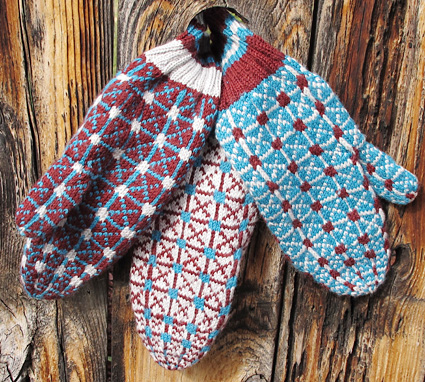 |
by Donna Druchunas While European knitters normally made mittens with pointed tips or by dividing the stitches into three or four equal sections for decreasing, I've used the North American style of maintaining the pattern all the way to the tip. My version uses the Lithuanian three-color variation of Compass and Rose. All three (yes, three) mittens use the same chart, but I changed the sequence of colors for each, resulting in a trio that uses an equal amount of each yarn. The mittens are made in such a way that they can be worn on either hand so, should you lose a mitten, it's really no loss! |
|
SIZE |
|
|
|
MATERIALS Notions |
| GAUGE |
32 sts/32 rounds = 4 inches in stockinette stitch over stranded color knitting |
|
PATTERN NOTES |
Make 3 mittens alike but change the color
sequence as desired – designate one yarn as A, one as B, as
C. The A color is the one used for the widest stripes in the
ribbing, the C color is the one that is used only once in the
ribbing. Do not cut the yarns when not in use, but rather, run the unused colors up the inside of the mitten loosely. Ribbing Pattern |
The charts for this pattern are very large and fit on a letter-sized page. Click here and print the resulting page. |
|
DIRECTIONS |
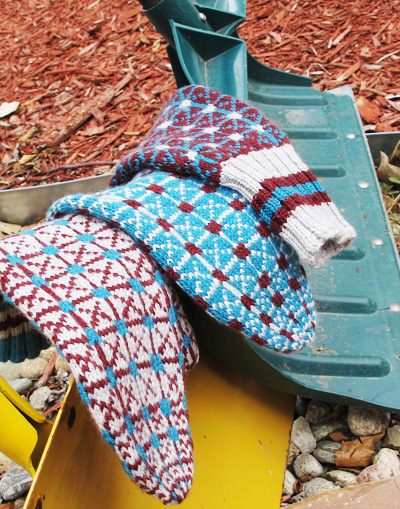 With smaller needles and A, cast on 48[56, 64] sts. Join to work in the round being careful not to twist stitches. Work in Ribbing Pattern in the following stripe sequence: Start Hand & Setup Pattern: Thumb Gore Shaping : Continue in pattern as set until row 9 of Thumb Gore chart is complete. 64[72, 80] sts – 16 sts between start of round and marker. Size L only: All sizes: Continue in pattern as set until you have worked 3 repeats of the Colorwork chart. Make thumb opening: Slip the first 16[16, 20] sts to scrap yarn and CO 8 sts over gap. HAND Tip Shaping: 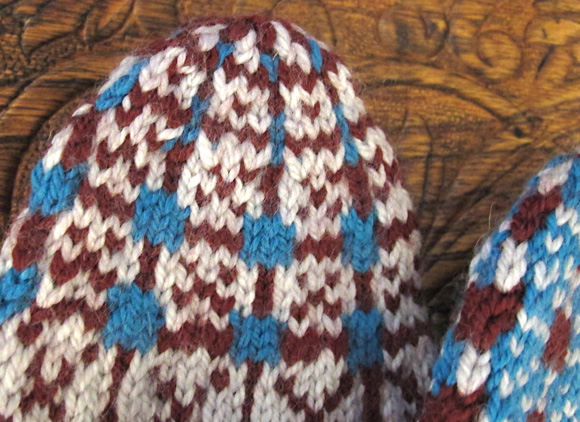
THUMB Sizes S + M only: Size L only: FINISHING |
|
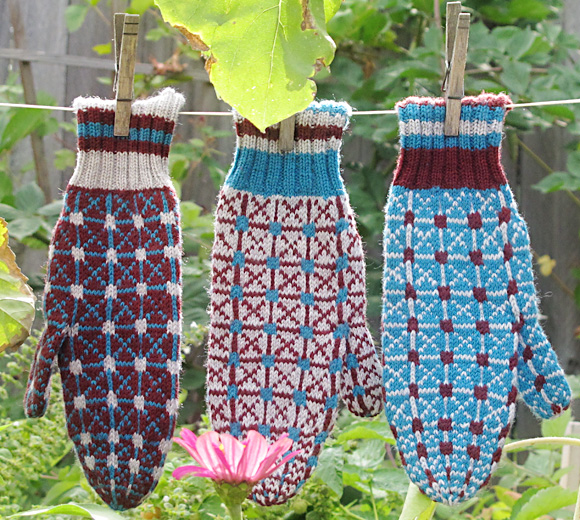
|
| ABOUT THE DESIGNER |
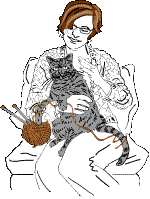 Visit Donna's website at sheeptoshawl.com. |
| Pattern & images © 2011 Donna Druchunas. Contact Donna |